Published by Joe Webster
Last updated Aug, 19 2025
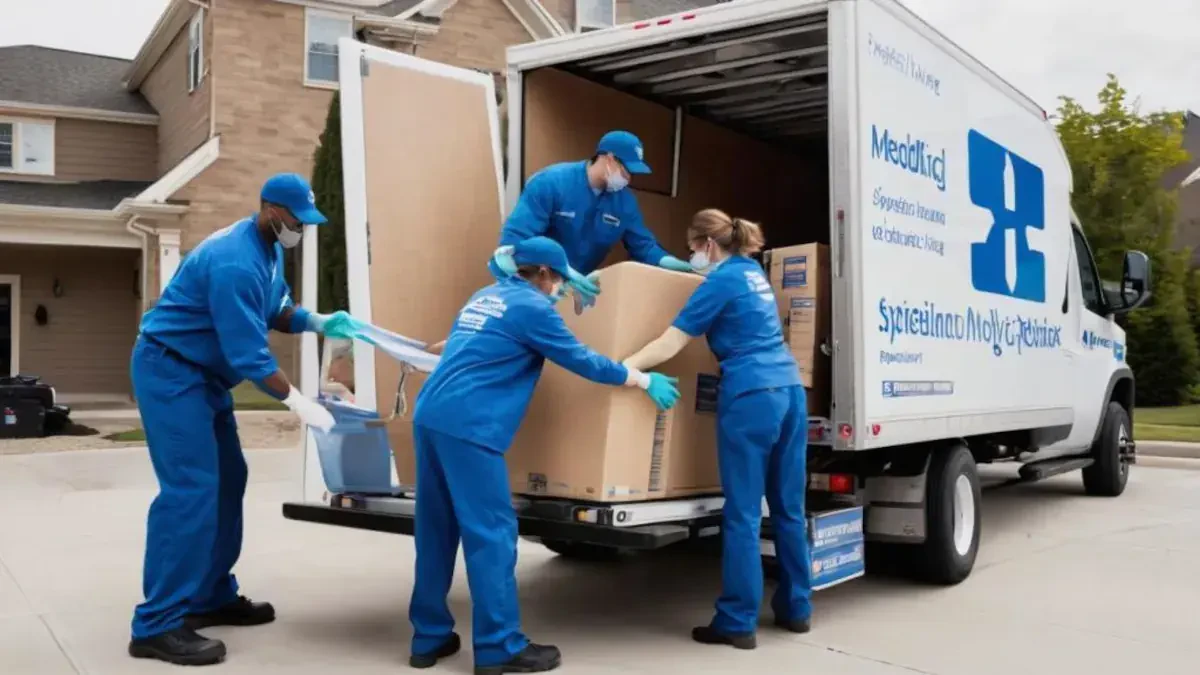
Selecting a Reputable Medical Office Moving Company
When it comes to relocating a medical office, experience and precision are paramount. Not every moving company is equipped to handle the unique challenges involved in safely and efficiently relocating sensitive medical equipment and records. As you embark on the search for a reputable medical office moving company, there are several key factors you should consider to ensure a smooth and secure transition for your valuable assets.
The first and most crucial consideration is to prioritize companies with a proven track record of success in healthcare relocations. These are companies that have substantial experience in handling the specific requirements of medical facilities. Moving delicate and expensive medical equipment, sensitive patient records, and ensuring compliance with healthcare regulations requires specialized knowledge and care.
For example, Three Movers is known for offering specialized moving services tailored to the unique requirements of healthcare environments. They provide expert assistance in relocating clinics, hospitals, urgent care centers, as well as moving high-value medical equipment such as incubators, MRIs, ultrasounds, x-rays, and ultra-low freezers. This level of expertise is crucial when entrusting a company with your medical office relocation.
Equally important is to verify the company's compliance with industry regulations. Healthcare facilities must adhere to a myriad of regulatory standards, and any moving company handling the relocation must understand and respect these regulations. Perform due diligence to ensure that the company is properly licensed, insured, and holds the necessary certifications to handle medical office relocations.
Once you're confident in the company's experience and adherence to industry regulations, turn your attention to its reputation within the industry.
Evaluating Reputation and Reviews
Hearing about other healthcare facilities' experiences working with the prospective moving company can provide invaluable insight into their reliability and professionalism. Seek out feedback from other healthcare providers or professional organizations regarding their experiences with the moving company under consideration.
Word-of-mouth recommendations from industry peers can be an excellent way to gauge a company's reliability and customer service. Positive reviews from other healthcare facilities provide reassurance that the company has successfully managed similar relocations in the past. Additionally, look for testimonials or case studies showcasing successful medical office relocations in which the company has been involved.
Moreover, platforms such as Google Reviews or Yelp can offer candid feedback from previous clients regarding their experiences with the moving company. Pay close attention to aspects such as promptness, professionalism, care taken with delicate equipment, and adherence to timelines. An overwhelmingly positive track record across these platforms can be indicative of a trustworthy and reliable mover.
With experience, compliance, and reputation thoroughly assessed, it’s also crucial to discuss pricing and insurance considerations when finalizing a contract with a medical office moving company.
Planning for Your Medical Office Move
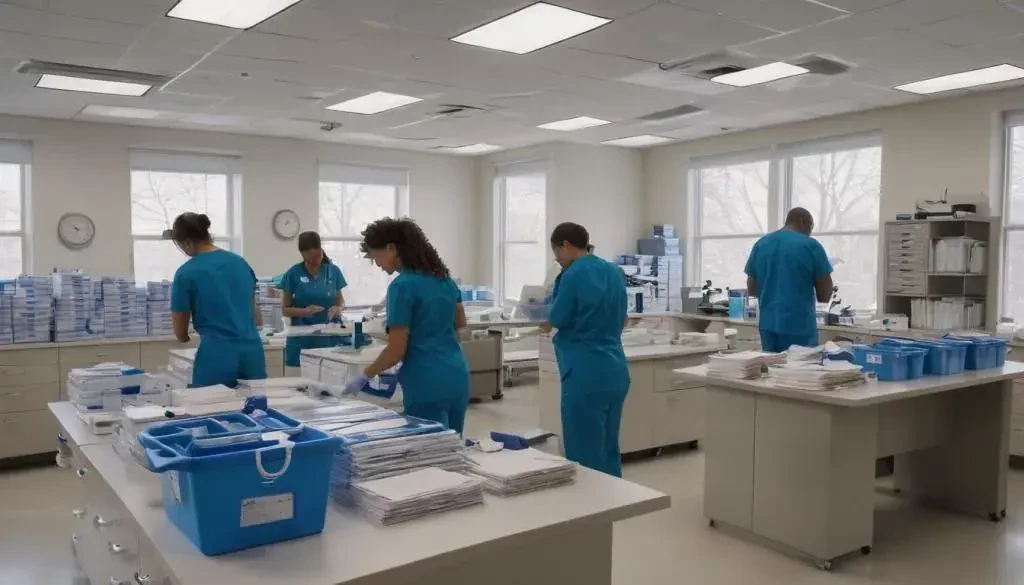
Moving a medical office requires meticulous planning and attention to detail. It involves more than just packing up boxes and transporting them to a new location. There are specialized equipment, delicate instruments, patient records, and important supplies that need to be managed carefully.
Conduct a Comprehensive Site Survey
Ensure to take note of the following key aspects during your site survey:
| Key Aspects | Description |
|---|---|
| Exact Size of New Space | Measure doorframes, hallways, and elevators at your new location to ensure all equipment and furniture will fit through easily. |
| Identify Technical Requirements | Check for electrical outlets, network cabling, and other technical requirements needed for medical equipment in the new space. |
| Staircases and Elevators | Take note of any limitations or special requirements related to staircases or elevators that could affect the moving process. |
Ensuring you're aware of these elements well in advance will help you better plan and arrange for any necessary modifications or accommodations before the moving day arrives.
Timeline and Coordination
Creating a detailed timeline is crucial for the success of your move. The timeline should include specific dates for packing, equipment disassembly, moving day, and office reassembly. Additionally, coordination with the moving company plays a pivotal role in ensuring a smooth transition without causing significant disruptions to patient care.
Here are some key points for coordinating with the moving company:
- Medical Equipment Handling: Detail how sensitive medical equipment should be handled and transported to ensure their safety during relocation.
- Communication Channels: Establish clear communication channels with the moving company’s team leaders to address any concerns or changes in plans promptly.
Maintaining regular contact with the moving company ensures that everyone involved is updated on progress, challenges, or adjustments in the schedule. This transparency is vital for maintaining operational continuity during the transition.
By meticulously planning each step of your move, from assessing logistical challenges to establishing tight coordination with your chosen mover, you can ensure a seamless relocation process while safeguarding the integrity of your medical practice. These proactive measures help mitigate potential disruptions and uphold patient care standards throughout the moving process.
Equipped with an informed plan and an understanding of the logistics involved in medical office relocations, the next critical step involves creating a data inventory and emergency plan that safeguards sensitive information during the shifting process.
Creating a Data Inventory and Emergency Plan
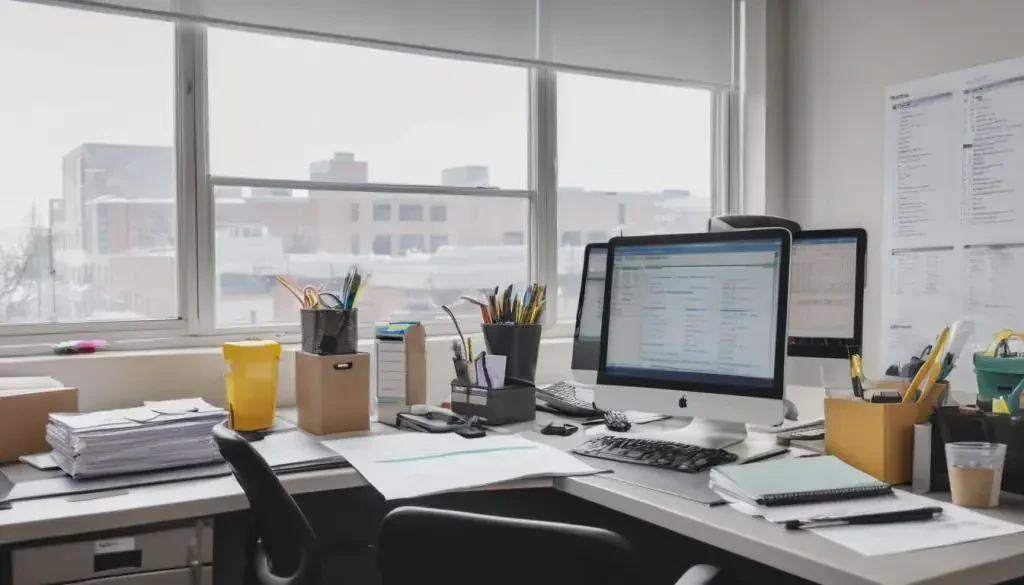
Moving a medical office requires precision and careful planning. Creating a detailed data inventory, including all medical equipment, supplies, and sensitive documents is vital to ensuring nothing is misplaced or damaged during the move. A comprehensive inventory management system not only streamlines the packing and unpacking process but also provides clarity and organization when setting up your new space.
The first step in creating a data inventory is to catalog all medical equipment, from large diagnostic machines to smaller tools such as stethoscopes and blood pressure monitors. Each item should be documented along with its unique specifications, such as model numbers, serial numbers, and any associated warranties or service records. It's essential to include a detailed description of the condition of each piece of equipment to accurately assess any damages incurred during transit.
Simultaneously, an itemized list of medical supplies should be compiled, detailing quantities, expiration dates, and storage requirements for each item. Categorizing supplies based on their nature—such as pharmaceuticals, surgical instruments, or disposable materials—facilitates a structured packing process and ensures easy access upon reaching the new location.
Equally important is safeguarding sensitive documents integral to the operation of the medical office. This includes patient records, administrative files, billing information, and legal documents. Implementing secure data management measures within your inventory system can prevent unauthorized access or loss during the relocation process. Utilizing digital backups or encrypted storage solutions can provide an additional layer of protection for critical information.
Consider utilizing barcoding or labeling systems when categorizing medical equipment and supplies. This can streamline the tracking process, providing an efficient method for verifying inventory at each stage of the move. Such meticulous organization ensures that no essential items are overlooked during packing or unloading.
Moving on to emergency preparedness—developing an emergency plan is crucial for addressing unexpected issues during the relocation process. Unforeseen circumstances such as equipment damage, transportation delays, or inclement weather may arise, calling for swift action to mitigate potential disruptions.
The emergency plan should delineate contingency measures for various scenarios that could impact the move. This includes outlining communication protocols among staff members, external moving professionals, and relevant stakeholders to relay updates regarding any unforeseen obstacles encountered throughout the move. Establishing points of contact and clear lines of communication can help maintain order and promptly address issues as they emerge.
Key Elements of an Emergency Plan
- Equipment Damage: Contingency measures to address potential damage to medical equipment during transport should be detailed.
- Transportation Delays: Plans for alternative transportation arrangements in case of unexpected delays should be clearly defined.
- Documentation Protocols: Procedures for securing sensitive documents should unforeseen situations arise need to be established.
A comprehensive data inventory and an effective emergency plan function as safeguard measures, ensuring that your medical office relocation proceeds seamlessly and securely.
As we navigate through the intricate landscape of relocating a medical office with precision and care, it becomes apparent how pivotal quality packing materials are in maintaining the integrity of crucial equipment and records.
Importance of Quality Packing Materials
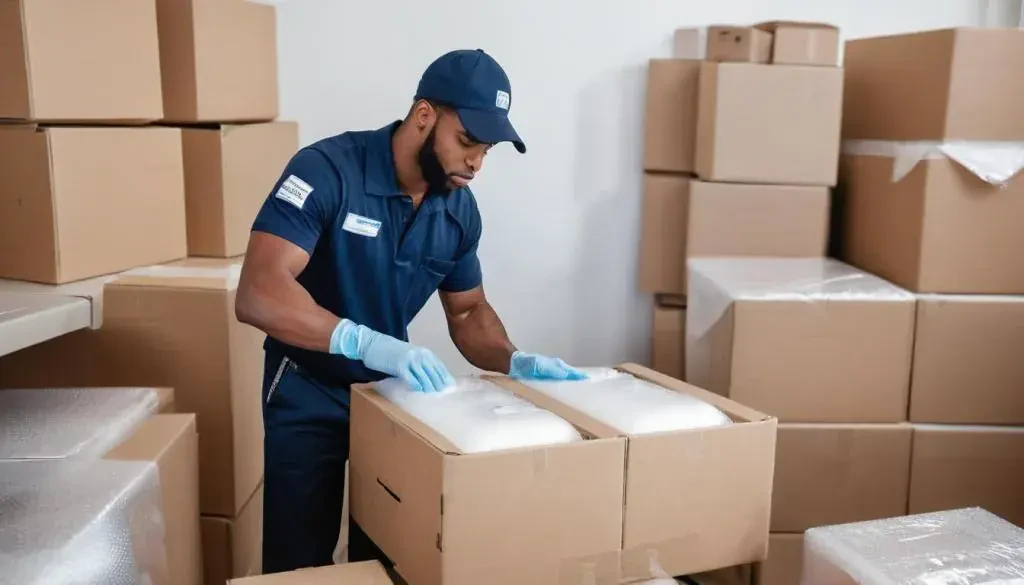
Moving medical equipment is a delicate task. The value of specialized, high-quality packing materials cannot be overstated. They play an essential role in ensuring the safe and secure transportation of your valuable medical equipment and supplies.
Investing in quality packing materials will provide reliable protection for your medical devices and prevent them from getting damaged during transit. This is especially important because some medical equipment is sensitive to impact, temperature changes, or moisture. Proper padding, cushioning, and secure containers are crucial to prevent jostling, shocks, or vibrations that could cause malfunction or damage.
Consider this analogy: just like how delicate items are carefully packaged when sent through the mail, medical equipment requires the same degree of care, if not more! Ensuring that each item is meticulously insulated and secured within a sturdy wrapper will minimize the risk of harm during the moving process.
A range of protective materials is necessary to ensure the safe relocation of various types of medical devices. This includes bubble wrap for delicate pieces like monitors and screens, cushioned boxes for instruments and tools, custom crates for larger machinery, and foam padding to line storage units for small items. Using these specialized materials helps absorb shock, alleviate pressure points, and safeguard components from harm-causing agents while in transit.
If you've ever ordered something fragile online, you might remember how satisfying it felt to see that box filled with bubble wrap. Now imagine that feeling but magnified in importance, making sure that all your essential medical tools reach their new home safely.
Remember: the cost of these materials pales in comparison to the expenses incurred in repairing or replacing damaged medical equipment.
Hence, investing in high-quality packing materials isn't an added expense; it's an essential measure to minimize risks and protect both your patients' well-being and your financial interests as a healthcare provider.
The safe relocation of medical equipment involves many facets beyond just packing materials. Let's now delve into the comprehensive steps involved in ensuring a smooth transition for your medical office.
Ensuring the Safe Transition of Your Medical Office
When relocating a medical office, there's a lot at stake given the transfer of highly sensitive equipment and confidential patient records. Meticulous planning and open communication with the moving company are essential in facilitating a safe transition. Establishing a protocol before the actual move is crucial, outlining specific requirements for handling and transporting delicate medical equipment.
The first step involves working closely with the moving company to conduct a comprehensive assessment of all the medical equipment that will be moved. This assessment includes a detailed inventory and information on any special handling requirements for individual items. Collaborating closely with the moving company allows for effective communication of any unique characteristics or sensitivities of the equipment. This level of transparency is essential as it enables the movers to plan ahead and implement protocols tailored to the specialized needs of your medical equipment.
For example, certain types of medical devices may be sensitive to vibrations or temperature changes. By informing the moving company about these concerns, they can take measures such as using anti-vibration packaging or ensuring temperature-controlled transportation to mitigate these risks. Moreover, secure loading and unloading procedures are equally important to minimize the risk of damage. Ensuring that the medical equipment is handled gently during loading and unloading calls for using specialist lifting equipment, providing additional padding for delicate items, and carefully orchestrating the entire process to minimize sudden movements that could impact the integrity of the equipment.
Temperature Control
Maintaining a stable environment throughout transportation is critical as fluctuating temperatures can have adverse effects on certain types of medical equipment, potentially causing damage or affecting calibration. Partnering with a reputable moving company that offers climate-controlled transportation ensures that temperature-sensitive equipment remains within its required range during transit.
In summary, establishing a thorough protocol in collaboration with your chosen moving company can significantly reduce the chances of accidents, damage, or malfunctions when relocating sensitive medical equipment. Effective communication and planning ahead can help guarantee a smooth and secure transition for your medical office.
Moving forward into our next segment, we'll delve into essential considerations related to insurance and liability in medical office relocations.
Insurance and Liability Considerations
When it comes to moving sensitive and costly medical equipment, ensuring a moving company's comprehensive insurance coverage is crucial. The security of your medical equipment and supplies during the relocation process should not be left to chance. A qualified medical office moving company should provide assurance that your valuable assets are fully protected in the event of unforeseen accidents or incidents during transit.
Understanding the extent of coverage and potential liabilities involves carefully reviewing the moving company's insurance policy, including the specific protections offered for different types of medical equipment and supplies. For example, sensitive medical devices such as MRIs, ultrasounds, x-ray machines, and other precision equipment require specialized protection due to their high value and delicate nature. The insurance policy should clearly outline the procedures for filing claims and address any potential gaps in coverage that may exist for certain types of equipment.
In addition to general liability coverage, it's essential to verify if the moving company offers additional insurance options tailored specifically for medical equipment. These extra layers of protection can provide added peace of mind for the relocation process. Some moving companies offer customizable insurance packages that allow clients to tailor coverage levels based on their unique needs.
Verifying that the moving company has comprehensive insurance coverage that includes liability protection for medical equipment and supplies is absolutely critical.
Furthermore, understanding potential liabilities related to the relocation process involves examining provisions for damage or loss of medical equipment. This requires a careful review of the terms and conditions of the insurance policy to grasp the scope of protection offered in various scenarios.
An insightful tip is to request detailed information regarding past claims and how they were handled by the moving company. Asking for references from other medical facilities that have utilized the services of the moving company can provide valuable insights into real-world experiences in dealing with insurance claims for damaged or lost items.
Some may argue that relying on a moving company's assurances regarding insurance coverage is sufficient. However, thoroughly understanding all aspects of the insurance policy and addressing any uncertainties upfront can prevent potential complications in the event of an unfortunate incident during the move.
By ensuring comprehensive insurance coverage and understanding potential liabilities, you are taking proactive steps to safeguard your medical office assets against unforeseen risks during the relocation process.
As essential as it is to ensure proper insurance coverage and understanding liabilities when moving sensitive medical equipment, there are specific strategies that can further enhance a smooth transition. Let's turn now to explore these key considerations for relocating specific medical equipment.
Keys to success when relocating specific medical equipment
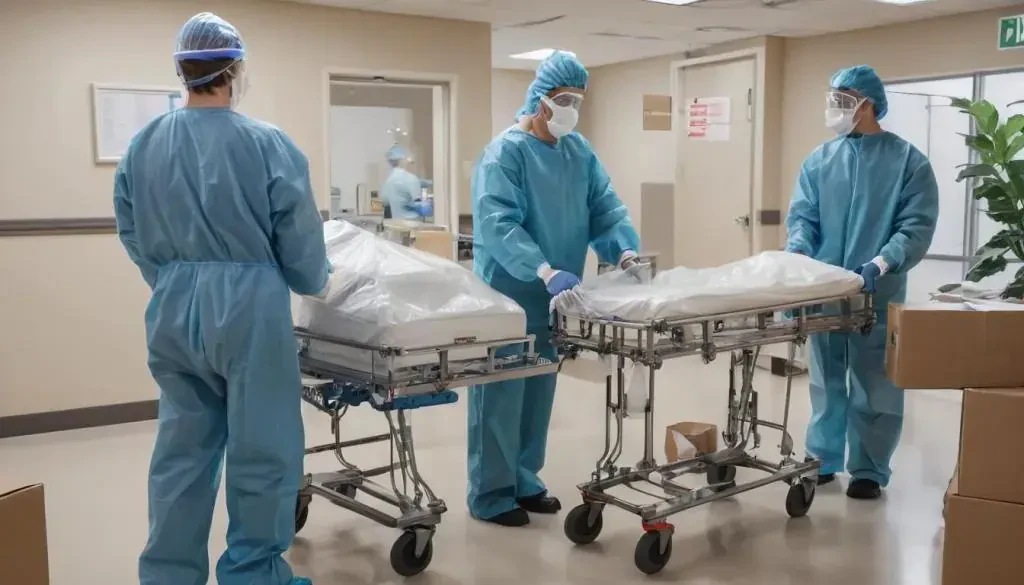
Moving a medical office is unique due to the presence of specialized and sensitive equipment. Ensuring the successful transfer of this equipment calls for particular considerations and expertise.
It's important to categorize the medical equipment into specific groups based on their nature and complexity. For instance, imaging equipment such as MRIs and CT scanners require meticulous disassembly and recalibration after transportation. These machines are intricate devices that can be easily compromised if mishandled. The relocation process for such high-value and delicate assets must be handled by expert movers with experience in these unique requirements.
On the other hand, laboratory equipment including centrifuges and analyzers present another set of challenges. Due to their precision and sensitivity to movement or vibrations, these pieces necessitate a tailored approach during relocation. It's crucial for moving companies to understand that laboratory instruments are not only expensive but also play a critical role in the functioning of healthcare facilities. Relocation providers must demonstrate expertise in ensuring the safe transport and reinstallation of these highly specialized machines.
One success strategy is implementing proper packaging techniques to secure these pieces of equipment during transit. For example, advanced shock-absorption methods may be required to protect delicate components during transport. In addition, using climate-controlled containers might be necessary to ensure the preservation of sensitive devices that are susceptible to temperature variations.
Furthermore, it's essential for medical office moving companies to have a comprehensive understanding of the manufacturer's guidelines, technical specifications, and maintenance procedures of each piece of medical equipment. This knowledge is crucial in ensuring that the relocating company's personnel handle each device appropriately throughout the entire transportation process. Failure to adhere to manufacturer specifications could result in irrevocable damage or compromised functionality.
Relocating medical equipment is far more complex than traditional moving processes due to the specialized handling requirements involved. As we've seen, precise planning and expertise are indispensable to successfully transport sensitive imaging machines and laboratory instruments without compromising their integrity or functionality.
As bump-free as smooth jazz on a Sunday morning, efficient medical relocation services provide a symphony of expertise and care. Now, let's step into the world behind that symphony with Three Movers - a case study in healthcare moving excellence.
Three Movers: A Case Study in Healthcare Moving Excellence
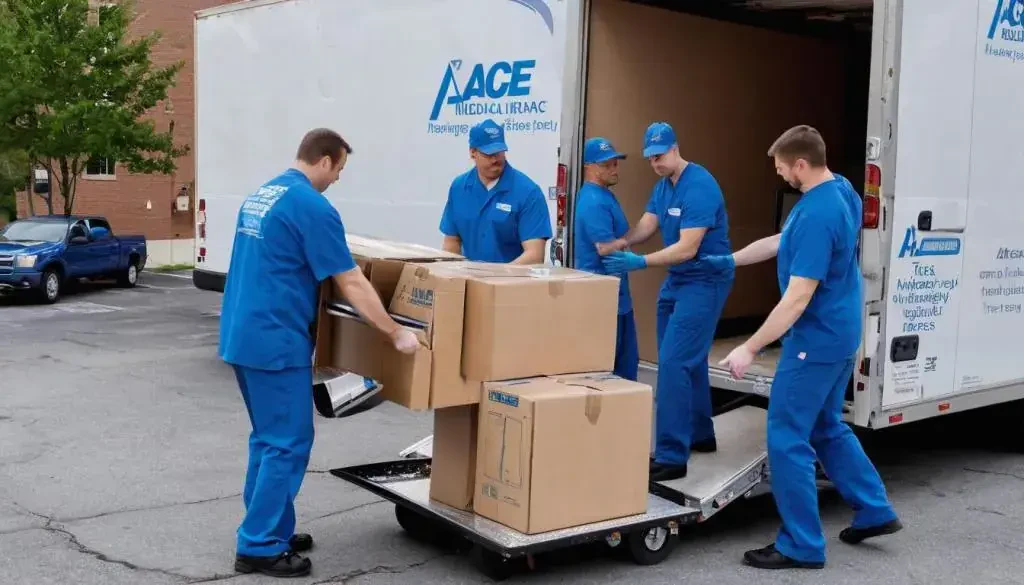
When it comes to relocating sensitive medical equipment and ensuring patient-care continuity, Three Movers stands out as a beacon of reliability and expertise. Their specific focus on healthcare relocations equips them with the knowledge and experience required to handle all aspects of moving medical facilities.
The relocation process for healthcare facilities is intricate and demands meticulous attention to detail - from the preliminary planning stages to securely transporting delicate and costly medical machinery. Three Movers has established a proven track record in executing seamless medical office transitions that ensure minimal downtime for their clients.
Their commitment to pre-move strategy and planning sets the stage for a well-coordinated relocation. Aligning their efforts with the unique requirements of each medical facility, Three Movers understands that no two healthcare institutions are exactly alike in their needs and priorities.
Furthermore, their expertise extends beyond just overseeing the physical move; it encompasses diligent measures aimed at preserving the integrity of crucial diagnostic and treatment equipment such as MRIs, ultrasounds, x-rays, and other highly sensitive devices. Three Movers ensures that every phase of the move is carried out with precision, preserving the functionality and safety of vital medical tools throughout the process.
This emphasis on technological proficiency correlates with robust security protocols and specialized handling techniques, including temperature regulation controls during transit. These measures are crucial in mitigating potential risks associated with expensive diagnostic machinery while also addressing concerns about data protection and operational reliability post-relocation.
The amalgamation of strategic foresight, unwavering diligence, and technical proficiency coalesces into a comprehensive suite of moving solutions tailored explicitly for healthcare environments. This manifests as a seamless transition for clinics, medical offices, hospitals, and urgent care centers alike.
On the grounds of this distinguished record, Three Movers emerges as an exemplar in safeguarding unwavering service quality for the pivotal domain of healthcare relocations. Their capability in seamlessly integrating strategic planning with stringent quality control establishes them as a dependable choice for addressing the specialized needs of medical community migrations.
Three Movers unparalleled excellence in healthcare relocations makes them a trusted partner in ensuring safe and efficient transitions for medical facilities.


